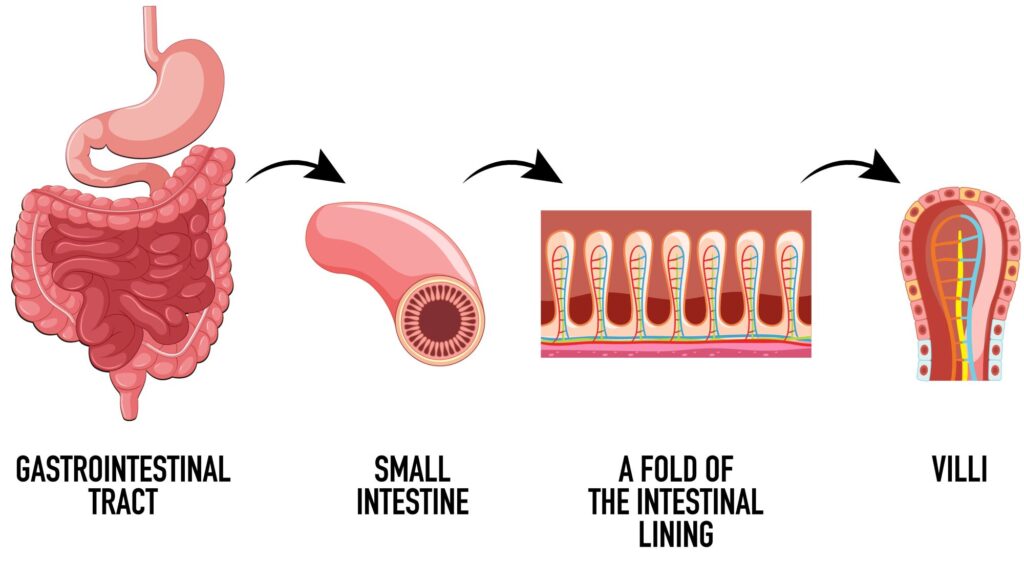Celiac disease is an immune-mediated inflammatory disease of the small intestines. Immune-mediated means that our immune system plays a main role in disease development. Here, the immune system attacks gluten molecules and damages the cells of the small intestines. This leads to malabsorption—the condition when small intestines are not able to properly absorb essential nutrients.
Celiac disease is also known as coeliac disease, celiac sprue, non-tropical sprue, and gluten-sensitive enteropathy.
There is not a definite cure for this disease, but avoiding gluten usually stops damage and relieves symptoms.
Celiac disease can affect people of any age, sex, and race. Estimated prevalence is approximately 1 percent worldwide. The risk of celiac disease is higher if you have one of the following:
- First- and second-degree relative with celiac disease
- type 1 diabetes
- Down syndrome, Williams syndrome, and Turner’s syndrome
- autoimmune thyroid disease
- microscopic colitis
- Addison’s disease
- pulmonary hemosiderosis
Symptoms
The manifestation of celiac disease varies from severe symptoms to asymptomatic disease. Classic symptoms are gastrointestinal (GI). GI symptoms include
- Abdominal pain
- Diarrhea
- Constipation
- Foul-smelling, greasy, and frothy stool
- Feeling bloated or full all the time
- Lack of appetite
- Bad gas
- Indigestion
- Vomiting
Malabsorption leads to general (extraintestinal) symptoms. Deficiencies of essential nutrients and vitamins (e.g., B and D vitamins, iron, and calcium) are responsible for diverse symptoms.
Dermatitis herpetiformis is a common finding in patients with celiac disease. Small, multiple itchy skin lesions occur mostly on elbows, forearms, knees, head and buttocks.
Atrophic glossitis (smooth and glossy tongue) is another common finding. Symptoms include soreness and a burning sensation of the tongue.
Bone loss happens due to vitamin D deficiency. Osteopenia and osteoporosis (reduced bone density) increase the risk of fractures.
Hematologic disorders related to celiac disease are iron deficiency anemia and hyposplenism (reduced functioning of the spleen). Symptoms of anemia are headaches, fatigue, and unexplained weight loss.
Celiac disease may also lead to neuropsychiatric symptoms, like headaches, peripheral neuropathy (burning, tingling, and numbness in your hands and feet), ataxia (problems with coordination and balance), depression, anxiety, and mood changes.
Malabsorption in children with celiac disease leads to:
- failure to thrive
- damage to tooth enamel
- weight loss
- short stature
- delayed puberty
- neurological symptoms (attention-deficit/hyperactivity disorder (ADHD), learning disabilities, headaches, coordination issues, lack of muscle strength, and seizures)
- iron deficiency
- bone loss
- heart muscle disease (cardiomyopathy)
Causes
Gluten is a protein that is found mainly in wheat, barley, and rye. In a healthy individual, gluten is digested by the GI tract. In contrast, by the immune system of a person with celiac disease gluten is recognized as a danger and attacks them in the lining of the small intestines.
The inner surface of the small intestine is covered by small fingerlike protrusions called villi. Their main functions are digestion and absorption of nutrients. Because of an immune system attack, they become inflamed (red and swollen), flat, and lose the ability of absorption.

The exact causes of celiac disease are not clear. Both genetic and environmental factors play a role in disease development. The latter means that gluten triggers an immune response only in genetically predisposed individuals.
Diagnosis
The symptoms of celiac disease are diverse and non-specific. The diagnosis is made based on tests.
Blood tests—This test reveals antibodies (specific proteins) that become elevated in people with celiac disease.
Small intestine biopsy— A small sample from the lining of the small intestine is taken during upper endoscopy and examined under a microscope.
Other tests—If a diagnosis of celiac disease is confirmed, you should undergo other tests to reveal micronutrient deficiencies (iron, vitamin D, folic acid, and vitamin B12). Clinicians also recommend a complete blood count, thyroid tests, and tests of bone loss.
Treatment
Celiac disease is treated by complete elimination of gluten from your diet. When you exclude gluten from your diet, the damage to your intestines stops. Symptoms begin to improve immediately after you start a gluten-free diet, but it may take weeks to replenish nutrients and several months for your intestines to fully recover.
Gluten-free diet
Gluten is mostly contained in wheat, barley, and rye. Gluten is also a hidden ingredient in a large number of prepared foods, medications and supplements, certain makeup products, etc. Thus, maintaining a gluten-free diet could be challenging. A dietitian will help you avoid gluten-containing food and make your diet balanced. The dietician can also educate you on how to read labels, grocery shopping, food preparation, and avoiding cross-contamination.
- Avoid gluten-containing foods (bread, pasta, cereals, biscuits or crackers, cakes and pastries, pies, gravies, and sauces), or replace them with gluten-free versions.
- Always read labels and buy products with “gluten-free” labeling.
- Naturally gluten-free foods (rice, corn, potatoes, oats, etc.) may be contaminated with wheat, barley, or rye. Choose “gluten-free” labeled versions of these products.
Even a tiny amount of gluten can trigger symptoms. If you have untreated or undiagnosed celiac disease and eat gluten, several complications can occur (malabsorption and malnutrition, cancer, infertility (difficulty getting pregnant), and high risk of coronary artery disease).
Sources:
UpToDate
Mayo Clinic







